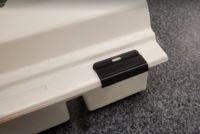CHEMNITZ, Germany—A European research project called COOLBat is developing next-generation battery enclosures for electric vehicles. The goal of the initiative is to improve charging power and range, while lowering environmental impact.
Engineers at the Fraunhofer Institute for Machine Tools and Forming Technology (IWU) are examining new ways to make battery enclosures lighter and cut carbon dioxide emissions by 15 percent. They aim to achieve this by combining individual systems, packing more functions into a smaller installation space, and using new heat-conductive materials and bio-based flame retardant coatings.
“Integrating new lightweight construction methods and more functions in a smaller installation space with fewer interfaces makes it possible to reduce weight while also cutting carbon emissions,” says Rico Schmerler, an engineer in the battery systems department at Fraunhofer IWU who is working on the project. “Reducing mass lets us increase energy density, and thus range, even as the number of battery cells stays the same. By making the enclosure lid out of a fiber composite material, we were able to reduce the mass by more than 60 percent compared to the reference out of steel.”
Another option for reducing weight is combining individual systems in the enclosure that previously performed thermal and mechanical functions separately. For example, cooling channels cast at the Fraunhofer Institute for Manufacturing Technology and Advanced Materials are incorporated directly into load-bearing structures such as cross beams.
The cooling unit function is combined with underride protection in a single component, the base plate. Aluminum foam inside the base plate absorbs the energy from stone impacts and accidents. Combined with a phase-change material, a kind of wax that can be used to store and later release a wealth of thermal and cooling energy, the aluminum foam also lowers the amount of energy needed to cool EV batteries.
According to Schmerler, this configuration protects battery cells from mechanical loads and overheating at once. A fluid flows through the channels, cooling the cells not only from below but also from the sides. This reduces the electricity needed to cool the cells and eliminates the need for cooling elements elsewhere in the vehicle.
“We’re focusing on functionally integrated structures,” explains Schmerler. “Tasks that used to be handled by different modules inside the battery are being integrated into a single component—the base assembly, in this case—to shrink the installation space and streamline interfaces. These base plates will provide protection from overheating and avert damage to the battery core in case of an accident.”
Schmerler and his colleagues are using batteries from a Mercedes-Benz EQS sport utility vehicle for their R&D project.







